
Cisthene is a genus of lichen moths in the family Erebidae. The genus was erected by Francis Walker in 1854.
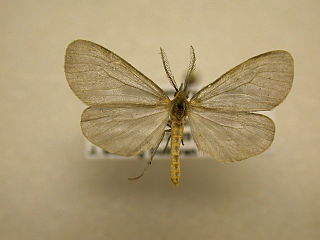
Pagara is a monotypic moth genus in the family Erebidae. Its only species, Pagara simplex, the mouse-colored lichen moth, is found in North America, where it has been recorded from Alabama, Arkansas, Florida, Georgia, Illinois, Indiana, Iowa, Kansas, Kentucky, Maryland, Mississippi, New Hampshire, North Carolina, Ohio, Oklahoma, South Carolina and Tennessee. Both the genus and species were described by Francis Walker in 1856.

Cisthene plumbea, the lead-colored lichen moth, is a moth of the family Erebidae. The species was first described by Richard Harper Stretch in 1885. It is found in eastern North America, from southern New Jersey south to northern Florida, west to Wisconsin and Texas.
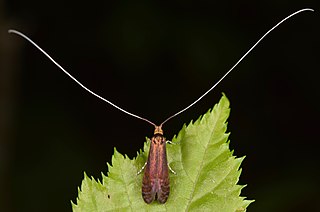
Adela caeruleella, the southern longhorn moth, is a moth of the family Adelidae or fairy longhorn moths. It was described by Francis Walker in 1863. It is found in North America, including Alabama, Arkansas, Florida, Illinois, Kentucky, Louisiana, Maryland, Mississippi, North Carolina, Ohio, Oklahoma, Pennsylvania, South Carolina, Tennessee, Texas, Virginia and West Virginia.

Cisthene angelus, the angel lichen moth, is a moth of the family Erebidae. It was described by Harrison Gray Dyar Jr. in 1904. It is found in North America, where it has been recorded from southern Nevada and Utah south to southern Arizona and western Texas.
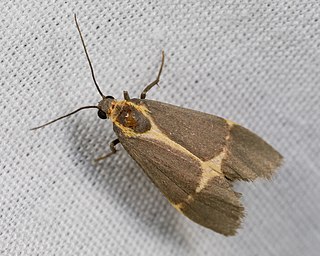
Cisthene barnesii, or Barnes' lichen moth, is a moth of the family Erebidae. It was described by Harrison Gray Dyar Jr. in 1904. It is found in the US Rocky Mountain region, from southern Montana and western North Dakota to the border with Mexico in Arizona and New Mexico. The habitat consists of dry bunchgrass steppe.
Cisthene deserta is a moth of the family Erebidae. It was described by Felder in 1868. It is found in North America, where it has been recorded from Utah and California.
Cisthene dorsimacula is a moth of the family Erebidae. It was described by Harrison Gray Dyar Jr. in 1904. It is found in southern California, United States.
Cisthene faustinula is a moth of the family Erebidae. It was described by Jean Baptiste Boisduval in 1869. It is found in California.
Cisthene fuscilingua is a moth of the family Erebidae. It was described by Harrison Gray Dyar Jr. in 1914. It is found in Panama.

Cisthene kentuckiensis, the Kentucky lichen moth, is a moth of the family Erebidae. It was described by Harrison Gray Dyar Jr. in 1904. It is found in the United States from New Jersey south to northern Florida, and west to Missouri, Oklahoma, and Texas.
Cisthene leuconotum is a moth of the family Erebidae. It was described by Harrison Gray Dyar Jr. in 1914. It is found in Panama.
Cisthene liberomacula is a moth of the family Erebidae. It was described by Harrison Gray Dyar Jr. in 1904. It is found along the coast of the US state of California. The habitat consists of areas with coastal live oaks.
Cisthene perrosea is a moth of the family Erebidae. It was described by Harrison Gray Dyar Jr. in 1904. It is found in the US from California to Utah, New Mexico and western Texas.
Cisthene striata, the striated lichen moth, is a moth of the family Erebidae. It was described by Rodrigues Ottolengui in 1898. It is found in the US states of Maryland, Colorado, Georgia and Florida.
Cisthene subrufa, the Tamaulipan lichen moth, is a moth of the family Erebidae. It was described by William Barnes and James Halliday McDunnough in 1913. It is found in the United States in Arizona and from San Benito, Texas south to Veracruz in Mexico.
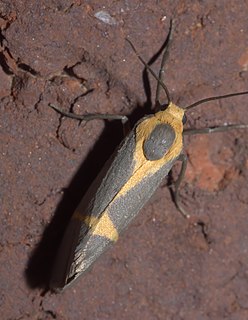
Cisthene tenuifascia, the thin-banded lichen moth or three-banded lichen moth, is a moth of the family Erebidae. It was described by Leon F. Harvey in 1875. It is found in Mexico and from Arizona to Florida, North Carolina and Oklahoma. Strays can be found further north.
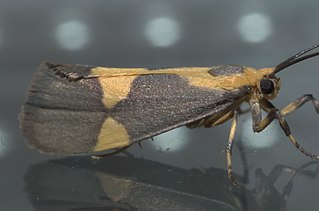
Cisthene unifascia is a moth of the family Erebidae. It was described by Augustus Radcliffe Grote and Coleman Townsend Robinson in 1868. It is found in the southern United States and Mexico.
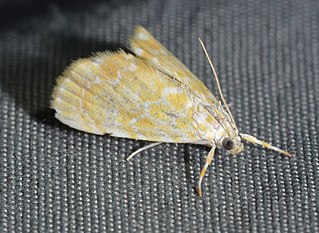
Glaphyria glaphyralis, the common glaphyria moth, is a moth in the family Crambidae. It was described by Achille Guenée in 1854. It is found in North America, where it has been recorded from Alabama, Arkansas, Florida, Georgia, Illinois, Indiana, Kentucky, Maryland, Massachusetts, Mississippi, Missouri, New Jersey, North Carolina, Ohio, Oklahoma, Ontario, Pennsylvania, South Carolina, Tennessee and West Virginia.
Pyrausta insignitalis, the dark-banded pyrausta moth, is a moth in the family Crambidae. It was described by Achille Guenée in 1854. It is found in the United States, where it has been recorded from Florida and South Carolina. It is also found on the West Indies, as well as in Central and South America.










